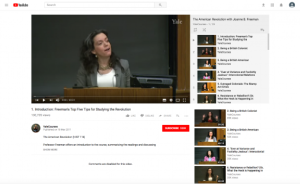 |
September 22, 2017 Volume 23, Number 38 |
Research and Education |
General Interest |
Network Tools |
In the News |
Research and EducationBack to Top | |
 |
|
 |
|
 |
|
 |
|
 |
|
 |
|
 |
|
 |
|
General InterestBack to Top | |
 |
|
 |
|
 |
|
 |
|
 |
|
 |
|
 |
|
 |
|
Network ToolsBack to Top | |
 |
|
 |
|
In the NewsBack to Top | |
Team of Amateur Archaeologists Find One-of-a-Kind Roman Mosaic in England | |
|
Rare Roman mosaic found during Berkshire community project Amateur archeologists unearth rare Roman mosaic hailed as 'best seen in decades' Amateur U.K. Archaeologists Stumble on a Roman Masterpiece A Brief Introduction to Roman Mosaics Heilbrunn Timeline of Art History: Mosaic Mosaic Art NOW A team of amateur archeologists and town residents in Berkshire, England, recently uncovered a Roman mosaic during the last few weeks of a community archaeology project. Historian Anthony Beeson described the experience as "without question, the most exciting mosaic discovery made in Britain in the last fifty years." The team consisted of 55 volunteers ranging in age from nine to 80 years, who were participating in a volunteer excavation headed by Cotswold Archeology with support from the Heritage Lottery Fund. This past August, the team had just two weeks (due to funding constraints) to work on excavating a site near the village of Boxford, where a Roman villa had been identified in 2016. The dig wound up being successful beyond all expectations when the team stumbled upon a six meter-wide mosaic strip. Joy Appleton, who was leading the volunteer effort as part of the Boxford History Project, recalled, "I was stunned into silence." The mosaic, dated from about fourth-century AD, portrays Greek mythological hero Bellerophon atop Pegasus. The mosaic also seems to portray Hercules and Cupid. Beeson, who is an expert on classical art and a member of the Association for the Study and Preservation of Roman Mosaics, described this mosaic as having a "very sophisticated design done in a slightly naive manner," suggesting that it was the work of an overly-ambitious artist. He also noted, "[i]t is so unusual because it has all sorts of quirks which you don't expect, and it has subjects on it that are completely alien to mosaics in this country." [MMB] The first three links take readers to summaries of this exciting archeological find featured in The Guardian, The Independent, and The New York Times. Next, readers may enjoy "A Brief Introduction to Roman Mosaics" from the Getty's blog The Iris. This blog provides a great opportunity to learn more about techniques of Roman mosaic artists and the role that these mosaics played in Roman society. This blog post also contains a link to curator Alexis Belis's digital publication Roman Mosaics in the J. Paul Getty Museum. Moving along, the fifth link takes visitors to images of mosaics available from The Metropolitan Museum of Art's spectacular Heilbrunn Timeline of Art History. Finally, visitors interested in contemporary mosaic artists will enjoy Mosaic Art NOW, an online magazine that "celebrate[s] the emergence of contemporary mosaics as a growing presence in the world of modern art." | |





